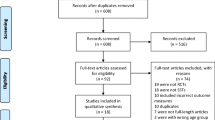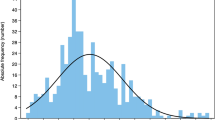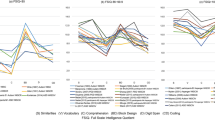Abstract
This study examined Chinese character recognition and its cognitive and linguistic correlates in preschool children with autism spectrum disorder (ASD). Forty-seven children with ASD and 51 IQ-matched typically developing (TD) children were tested on Chinese character recognition, rapid automatized naming, inhibitory control, digit span, IQ, vocabulary, phonological awareness, morphological awareness, and listening comprehension. Chinese children with ASD showed strong character recognition skills. Unlike TD children’s character recognition, which was correlated with all the measured cognitive and linguistic skills, character recognition of children with ASD was only significantly correlated with rapid automatized naming, inhibitory control, and phonological awareness. Our findings suggest that phonological awareness and rapid automatized naming may serve as important predictors for possible advantage in emergent literacy acquisition in Chinese children with ASD.
Similar content being viewed by others
Notes
The standardized non-verbal IQ scores were established only for children over 5 years old. Children under five in this study therefore did not get the standardized score. The standardized non-verbal IQ scores for TD children and children with ASD over 5 years old were 98.5 and 74.9, respectively. Children under 5 years old consitituted 51% of the TD children and 39.1% of children with ASD.
TEACCH refers to a framework that offers structured support for social communication using visual and/or written information to supplement verbal communication.
References
American Psychiatric Association. (2000). Diagnostic and statistical manual of mental disorders (4th ed., pp. 553–557). Washington, DC: American Psychiatric Association.
American Psychiatric Association. (2013). Diagnostic and statistical manual of mental disorders (5th ed.). Washington, DC: American Psychiatric Association.
Anderson, R. C., Ku, Y. M., Li, W., Chen, X., Wu, X., & Shu, H. (2013). Learning to see the patterns in Chinese characters. Scientific Studies of Reading,17, 41–56.
Auyeung, B., Baron-Cohen, S., Wheelwright, S., & Allison, C. (2008). The autism spectrum quotient: Children’s version (AQ-Child). Journal of Autism and Developmental Disorders,38(7), 1230–1240. https://doi.org/10.1007/s10803-007-0504-z.
Bialystok, E. (2001). Metalinguistic aspects of bilingual processing. Annual Review of Applied Linguistics,21, 169–181.
Castles, A., Crichton, A., & Prior, M. (2010). Developmental dissociations between lexical reading and comprehension: Evidence from two cases of hyperlexia. Cortex,46, 1238–1247.
Centers for Disease Control and Prevention (CDC). (2018). Autism spectrum disorder (ASD). Retrieved from https://www.cdc.gov/ncbddd/autism/index.html
Child Assessment Service, Department of Health, Hong Kong SAR. (2006). Hong Kong cantonese oral language assessment scale. Hong Kong: Language Information Sciences Research Centre, City University of Hong Kong.
Chung, K. K. H., & McBride-Chang, C. (2011). Executive functioning skills uniquely predict Chinese word reading. Journal of Educational Psychology,103, 909–921. https://doi.org/10.1037/a0024744909.
Constantino, J. N., & Gruber, C. P. (2002). The social responsiveness scale. Los Angeles: Western Psychological Services.
Dynia, J. M., Brock, M. E., Justice, L. M., & Kaderavek, J. N. (2017). Predictors of decoding for children with autism spectrum disorder in comparison to their peers. Research in Autism Spectrum Disorders,37, 41–48. https://doi.org/10.1016/j.rasd.2017.02.003.
El Zein, F., Solis, M., Vaughn, S., & McCulley, L. (2014). Reading comprehension interventions for students with Autism Spectrum Disorders: A synthesis of research. Journal of Autism and Developmental Disorders,44(6), 1303–1322. https://doi.org/10.1007/s10803-013-1989-2.
Frith, U. (1989). Autism: Explaining the enigma. Cambridge: Blackwell.
Gathercole, S. E., Pickering, S. J., Ambridge, B., & Wearing, H. (2004). The structure of working memory from 4 to 15 years of age. Developmental Psychology,40, 177–190. https://doi.org/10.1037/0012-1649.40.2.177.
Georgiou, G. K., Aro, M., Liao, C.-H., & Parrila, R. (2016). Modeling the relationship between rapid automatized naming and literacy skills across languages varying in orthographic consistency. Journal of Experimental Child Psychology,143, 48–64. https://doi.org/10.1016/j.jecp.2015.10.017.
Gliga, T., Bedford, R., Charman, T., Johnson, M. H., & The BASIS team. (2015). Enhanced visual search in infancy predicts emerging Autism symptoms. Current Biology,25, 1–4.
Grigorenko, E. L., Volkmar, F., & Klin, A. (2003). Hyperlexia: Disability or superability? Journal of Child Psychology and Psychiatry,44, 1079–1091.
Happé, F., & Frith, U. (2006). The weak coherence account: detail focused cognitive style in autism spectrum disorders. Journal of Autism and Developmental Disorders,36(1), 5–25.
Huemer, S. V., & Mann, V. (2010). A comprehensive profile of decoding and comprehension in Autism Spectrum Disorders. Journal of Autism Development Disorders,40, 485–493.
Li, M., Kirby, J., Cheng, L., Wade-Woolley, L., & Qiang, H. (2012a). Cognitive predictors of English reading achievement in Chinese English-immersion students. Reading Psychology,33(5), 423–447. https://doi.org/10.1080/02702711.2010.528663.
Li, H., Shu, H., McBride-Chang, C., Liu, H., & Peng, H. (2012b). Chinese children’s character recognition: Visuo-orthographic, phonological processing and morphological skills. Journal of Research in Reading,35(3), 287–307.
Liao, C.-H., Georgiou, G. K., & Parrila, R. (2008). Rapid naming speed and Chinese character recognition. Reading and Writing,21, 231–253. https://doi.org/10.1007/s11145-007-9071-0.
Lord, C., Risi, S., Lambrecht, L., Cook, E. H., Leventhal, B. L., DiLavore, P. C., et al. (2000). The Autism Diagnostic Observation Schedule—Generic: A standard measure of social and communication deficits associated with the spectrum of autism. Journal of Autism and Developmental Disorders,30, 205–223.
Lord, C., Rutter, M., & Le Couteur, A. (1994). Autism diagnostic interview-revised: A revised version of a diagnostic interview for caregivers of individuals with possible pervasive developmental disorders. Journal of Autism and Developmental Disorders,24, 659–685.
McBride-Chang, C., & Ho, C. (2000). Developmental issues in Chinese children’s character acquisition. Journal of Educational Psychology,92, 50–55.
McBride-Chang, C., Shu, H., Zhou, A., Wat, C. P., & Wagner, R. K. (2003). Morphological awareness uniquely predicts young children’s Chinese character recognition. Journal of Educational Psychology,95, 743–751.
McBride-Chang, C., Tong, X. L., Shu, H., Wong, A. M. Y., Leung, K. W., & Tardif, T. (2008). Syllable, phoneme, and tone: Psycholinguistic units in early Chinese and English word recognition. Scientific Studies of Reading,12(2), 171–194. https://doi.org/10.1080/10888430801917290.
McIntyre, N. S., Solari, E. J., Grimm, R. P. E., Lerro, L. E., Gonzales, J., & Mundy, P. C. (2017). A comprehensive examination of reading heterogeneity in students with high functioning autism: Distinct reading profiles and their relation to autism symptom severity. Journal of Autism and Developmental Disorders,47, 1086–1101. https://doi.org/10.1007/s10803-017-3029-0.
Miller, L. E., Burke, J. D., Troyb, E., Knoch, K., Herlihy, L. E., & Fein, D. A. (2017). Preschool predictors of school-age academic achievement in autism spectrum disorder. The Clinical Neuropsychologist,31, 382–403. https://doi.org/10.1080/13854046.2016.1225665.
Murdaugh, D. L., Deshpande, H. D., & Kana, R. K. (2015). The impact of reading intervention on brain responses underlying language in children with autism. Autism Research,9, 141–154. https://doi.org/10.1002/aur.1503.
Nation, K. (1999). Reading skills in hyperlexia: A developmental perspective. Psychological Bulletin,125(3), 338–355.
Nation, K., Clarke, P., Wright, B., & Williams, C. (2006). Patterns of reading ability in children with autism spectrum disorder. Journal of Autism and Developmental Disorders,36, 911–919. https://doi.org/10.1007/s10803-006-0130-1.
Newman, T. M., Macomber, D., Naples, A. J., Babits, T., Volkmar, F., & Grigorenko, E. L. (2007). Hyperlexia in children with Autism Spectrum Disorders. Journal of Autism and Developmental Disorders,37, 760–774.
Norbury, C., & Nation, K. (2011). Understanding variability in reading comprehension in adolescents with Autism Spectrum Disorders: Interactions with language status and decoding skill. Scientific Studies of Reading,15, 191–210. https://doi.org/10.1080/10888431003623553.
Ostrolenk, A., Forgeot d’Arc, B., Jelenic, P., Samson, F., & Mottron, L. (2017). Hyperlexia: Systematic review, neurocognitive modelling, and outcome. Neuroscience and Biobehavioral Reviews,79, 134–149. https://doi.org/10.1016/j.neubiorev.2017.04.029.
Pan, J., McBride-Chang, C., Shu, H., Liu, H., Zhang, Y., & Li, H. (2011). What is in the naming? A 5-year longitudinal study of early rapid naming and phonological sensitivity in relation to subsequent reading skills in both native Chinese and English as a second language. Journal of Educational Psychology,103, 897–908.
Pan, J., Song, S., Su, M. M., McBride, C., Liu, H. Y., Zhang, Y. P., et al. (2016). On the relationship between phonological awareness, morphological awareness and Chinese literacy skills: Evidence from an 8-year longitudinal study. Developmental Science,19, 982–991. https://doi.org/10.1111/desc.12356.
Plaut, D. C. (2005). Connectionist approaches to reading. In M. J. Snowling & C. Hulme (Eds.), The science of reading: A handbook (pp. 24–38). Malden: Blackwell.
Raven, J. C., Court, J. H., & Raven, J. (1996). Manual for Raven’s standard progressive matrices. Oxford: Oxford Psychologists Press.
Sang, B., & Miao, X. (1990). The revision of trail norm of peabody picture vocabulary test revised (PPVT-R) in Shanghai proper. Psychological Science,5, 20–25. (In Chinese).
Seidenberg, M. S., & McClelland, J. L. (1989). A distributed, developmental model of word recognition. Psychological Review,96, 523–568.
Shu, H., Anderson, R. C., & Wu, N. (2000). Phonetic awareness: Knowledge of orthography–phonology relationships in the character acquisition of Chinese children. Journal of Educational Psychology,92, 56–62.
Shu, H., McBride-Chang, C., Wu, S., & Liu, H. Y. (2006). Understanding Chinese developmental dyslexia: Morphological awareness as a core cognitive construct. Journal of Educational Psychology,98(1), 122–133. https://doi.org/10.1037/0022-0663.98.1.122.
Shu, H., Peng, H., & McBride-Chang, C. (2008). Phonological awareness in young Chinese children. Developmental Science,11, 171–181. https://doi.org/10.1111/j.1467-7687.2007.00654.x.
Snow, C. E., Burns, M. S., & Griffin, P. (Eds.). (1998). Preventing reading difficulties in young children. Washington, DC: National Academy Press.
Snowling, M., & Frith, U. (1986). Comprehension in ‘‘hyperlexic’’ readers. Journal of Experimental Child Psychology,42, 392–415.
Song, S., Georgiou, G. K., Su, M., & Shu, H. (2016). How well do phonological awareness and rapid automatized naming correlate with Chinese reading accuracy and fluency? A meta-analysis. Scientific Studies of Reading,20, 99–123. https://doi.org/10.1080/10888438.2015.1088543.
Tong, X., & McBride, C. (2014). Chinese children’s statistical learning of orthographic regularities: Positional constraints and character structure. Scientific Studies of Reading,18, 291–308. https://doi.org/10.1080/10888438.2014.884098.
Tong, X., & McBride-Chang, C. (2010a). Developmental models of learning to read Chinese words. Developmental Psychology,46(6), 1662. https://doi.org/10.1037/a0020611.
Tong, X., & McBride-Chang, C. (2010b). Chinese-English biscriptal reading: cognitive component skills across orthographies. Reading and Writing,23, 293–310. https://doi.org/10.1007/s11145-009-9211-9.
Tong, X. L., McBride-Chang, C., Shu, H., & Wong, A. M. Y. (2009). Morphological awareness, orthographic knowledge, and spelling errors: Keys to understanding early Chinese literacy acquisition. Scientific Studies of Reading,13(5), 426–452. https://doi.org/10.1080/10888430903162910.
Tong, X., Tong, X., & McBride, C. (2017). Unpacking the relation between morphological awareness and Chinese word reading: Levels of morphological awareness and vocabulary. Contemporary Educational Psychology,48, 167–178. https://doi.org/10.1016/j.cedpsych.2016.07.003.
Turkeltaub, P. E., Gareau, L., Flowers, D. L., Zeffiro, T. A., & Eden, G. F. (2003). Development of neural mechanisms for reading. Nature Neuroscience,6, 767–773.
Vanegas, S. B., & Davidson, D. (2015). Investigating distinct and related contributions of weak central coherence, executive dysfunction, and systemizing theories to the cognitive profiles of children with Autism Spectrum Disorders and typically developing children. Research in Autism Spectrum Disorders,11, 77–92. https://doi.org/10.1016/j.rasd.2014.12.005.
White, S., Frith, U., Milne, E., Rosen, S., Swettenham, J., & Ramus, F. (2006). A double dissociation between sensorimotor impairments and reading disability: A comparison of autistic and dyslexic children. Cognitive Neuropsychology,23, 748–761. https://doi.org/10.1080/02643290500438607.
Zelazo, P. D. (2006). The Dimensional Change Card Sort (DCCS): A method of assessing executive function in children. Nature Protocols,1, 297–301.
Zhang, H., & Wang, X. (1989). Standardization research on Raven’s standard progressive matrices in China. Acta Psychologica Sinica,2, 113–120. (in Chinese).
Ziegler, J. C., Bertrand, D., Tórth, D., Csépe, V., Reis, A., Faı´sca, L., et al. (2010). Orthographic depth and its impact on universal predictors of reading: A cross-language investigation. Psychological Science,21, 551–559. https://doi.org/10.1177/0956797610363406.
Acknowledgments
The authors would like to thank all children and their parents who participated in this study.
Funding
This work was supported by the National Social Science Fund of China [13CYY027] and the Fundamental Research Funds for the Central Universities [15000-31620003] to the first author.
Author information
Authors and Affiliations
Contributions
JZ and LY developed the study concept. All four authors contributed to the study design and SC analyzed the data. Testing and data collection were performed by JZ and LY. JZ drafted the manuscript, and XT provided critical revisions. All authors approved the final version of the manuscript for submission.
Corresponding authors
Ethics declarations
Conflict of interest
The authors declare that they have no conflict of interest.
Ethical Approval
All procedures performed in studies involving human participants were in accordance with the ethical standards of the institutional and/or national research committee and with the 1964 Helsinki declaration and its later amendments or comparable ethical standards.
Informed Consent
Informed consent was obtained from all individual participants included in the study.
Additional information
Publisher's Note
Springer Nature remains neutral with regard to jurisdictional claims in published maps and institutional affiliations.
Rights and permissions
About this article
Cite this article
Zhao, J., Chen, S., Tong, X. et al. Advantage in Character Recognition Among Chinese Preschool Children with Autism Spectrum Disorder. J Autism Dev Disord 49, 4929–4940 (2019). https://doi.org/10.1007/s10803-019-04202-x
Published:
Issue Date:
DOI: https://doi.org/10.1007/s10803-019-04202-x




